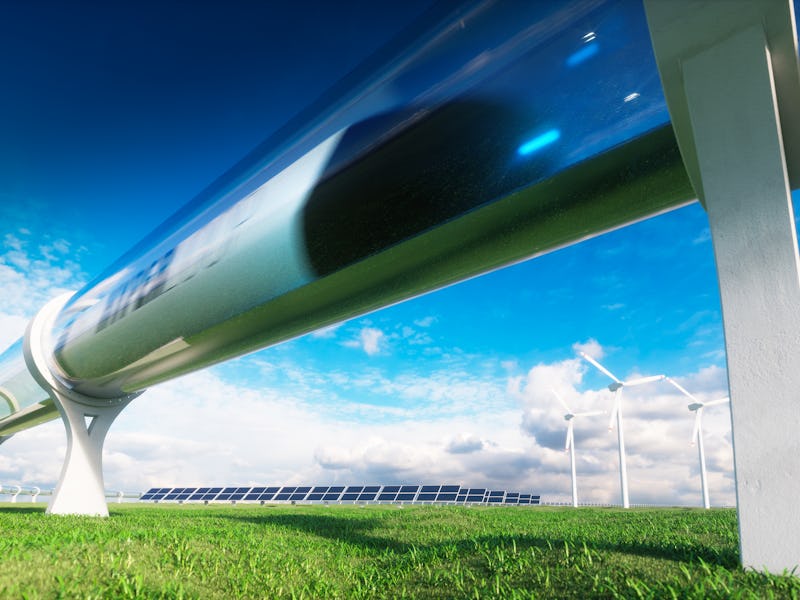Hyperloop: Elon Musk outlines new event that may bring it closer to reality
Hyperloop, the vacuum-sealed pod transit system, could take a step closer to a publicly-available system.

Hyperloop, the vacuum-sealed pod transit system designed by Elon Musk, may be about to take a step closer to reality thanks to a new competition.
On Thursday, the Tesla and SpaceX CEO explained his plan for a fifth hyperloop design competition. These events, held at the SpaceX campus in Hawthorne, California, pit teams against each other to design the best pod for the transit system. The first four events were held using a 0.8-mile-long, 72-inches-wide straight test tube with no curves.
Musk wrote on Twitter that the fifth competition will tweak this setup to better reflect real-world conditions, while also providing a longer track. Hyperloop teams have previously said that longer tracks are crucial to reaching the potential top speeds:
"We need to finish building a much longer vacuum tunnel for speed tests & probably have an additional competition for tunneling itself. […] Aiming for 10km [6.2 miles] with lots of turns to better approximate a real-world tunnel."
Elon Musk's post.
Musk first announced plans for a 10-kilometer track "with a curve" in July 2017. This week's announcement suggests this plan has increased in complexity, and it's part of a more focused effort to simulate real-world conditions. Musk's post also suggests plans to further involve The Boring Company tunnel-digging venture, which previously supplied the bricks for Musk's podium at the July 2018 competition.
It could be a big step forward for the pod transit system, first outlined in a 2013 white paper. The paper details a system where pods could move up to 760 mph, thanks to reduced air resistance. That could mean the 380-mile trip between Los Angeles and San Francisco taking around 35 minutes. Such a track could cost $6 billion for two one-way tubes, 40 capsules with 28 people each, and a ticket price of $20.
Musk also suggested in the paper that it could offer zero-emissions transport: “By placing solar panels on top of the tube, the Hyperloop can generate far in excess of the energy needed to operate.”
SpaceX held its first hyperloop pod design competition back in 2017, and each one has gradually set faster travel speeds:
- The first competition, in January 2017, gave the top prize to Netherlands-based Delft Hyperloop. This competition was judged on a number of criteria, so Munich-based TUM’s predecessor WARR Hyperloop reached the fastest speeds at over 56 mph.
- The second, in August 2017, was where WARR again scored the fastest speed at 201 mph.
- The third, in July 2018, was where WARR got its third fastest speed accolade at 284 mph.
- In the fourth and most recent competition in July 2019, WARR successor TUM Hyperloop grabbed the team's fourth fastest speed accolade at 288 mph.
A longer track with curves could help teams reach the hypothetical top speeds. Delft Hyperloop told Inverse in 2018 that a team could reach the top speeds with a track measuring 44 miles. TUM Hyperloop told Inverse in 2019 that it could be done with just nine miles of track.
The big question is around acceleration rates, and providing a comfortable trip for passengers. TUM reasoned at the time that buses and trains accelerate at 0.3g, where one small g is the acceleration rate of a falling object due to gravity. One small g is 9.8 meters per second squared. TUM Hyperloop's previous pod, by comparison, accelerates at 2g. A longer track would mean a more gradual acceleration and the chance to reach the higher speeds.
With the coronavirus pandemic, it seems SpaceX is unlikely to host a competition in the near future. In lieu of this, Delft Hyperloop has been running its own tests in June on a short and long test track. The longer track measures 0.4 kilometers, or a quarter of a mile. Not quite the same length as Musk's proposed track, but perhaps better than nothing.
The Inverse analysis – The hyperloop could take decades to become a publicly-available track that accepts passengers. But SpaceX's competitions have demonstrated that, even if it seems a long shot, there is a dedicated community of engineers passionate about bringing the idea to life. The fifth competition, whenever it occurs, could help those teams reach higher speeds than ever.